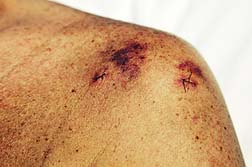 "They [doctors] used the pain pump in 2003 and then again in 2004," Sarah says. "In 2003, I believe it was to 'tighten up' the joint. For the second surgery, my shoulder had frozen and they were trying to loosen up the scar tissue to help with its mobility. Both surgeries were on the left shoulder."
"They [doctors] used the pain pump in 2003 and then again in 2004," Sarah says. "In 2003, I believe it was to 'tighten up' the joint. For the second surgery, my shoulder had frozen and they were trying to loosen up the scar tissue to help with its mobility. Both surgeries were on the left shoulder."Unfortunately, that second surgery did little to help with Sarah's pain or mobility in the shoulder. Sarah says she began to wonder about her shoulder when it felt as though bones in the joint were scraping together as she moved.
"It had gotten so painful that I was doing vocational rehab school and by 8:00 AM I was already taking Darvocet [a pain medication]," Sarah says. "An hour's worth of getting up and getting ready [in the morning] would set it over the edge, so that was an indicator that something more needed to be done. The doctor did diagnostics and found out the joint had totally deteriorated, so we went in [in 2005] and replaced it."
Despite the shoulder replacement surgery, Sarah says she still has pain and still takes pain medication to help her cope. Sarah has been diagnosed with post arthroscopic glenohumeral chondrolysis (PAGCL). PAGCL is a painful condition that has been linked to the use of shoulder pain pumps following arthroscopic surgery. Patients with PAGCL experience a deterioration in the cartilage in their shoulder joint, making it much more difficult and painful for them to move that joint.
Recently, reports have surfaced that the shoulder pain pump was not approved for administering pain medication directly into the shoulder joint. In fact, the pain pump was reportedly rejected by the Food and Drug Administration (FDA) 3 times when the manufacturer applied for approval to have doctors apply the device directly to the patient's shoulder joint. However, manufacturers allegedly continued to promote the pain pump for that use, despite the FDA having never approved it.
"There are some days where I can't hold a coffee cup and other days where I can," Sarah says. "I have pain when I'm not moving it. I'll be sitting and watching television and the shoulder will hurt. It hurts during the night. I have no muscle anymore. I don't know if it's because of the pain pump or because I haven't moved it a lot since the initial injury, but I can't build muscle in that shoulder, so it is very difficult to do anything with it.
I find that I may wake up feeling okay, but the smallest thing could potentially trigger the pain. The weakness from the shoulder can also create issues with my neck. The muscles from my neck to shoulder get really tight trying to help support the shoulder. Simple things like keeping my house clean and organized have become difficult. My home used to be spotless but is not anymore. I wake up and choose what I will be able to do and leave the rest for another day. It is that way with everything: phone calls to make or answer, bills to pay and even errands to run. I choose what I can do as a way of managing the pain.
READ MORE SHOULDER PAIN PUMP LEGAL NEWS
Sarah sought legal advice, where she learned that the shoulder pain pump may have caused her shoulder problems. She is represented by Magana, Cathcart & McCarthy.
"People need to be proactive and educated about medical issues," Sarah says. "That's the only way to figure out what is happening to you. Be educated, know your injury, keep documentation and do research so that you are aware of what is going on. I hope this story helps somebody else."
